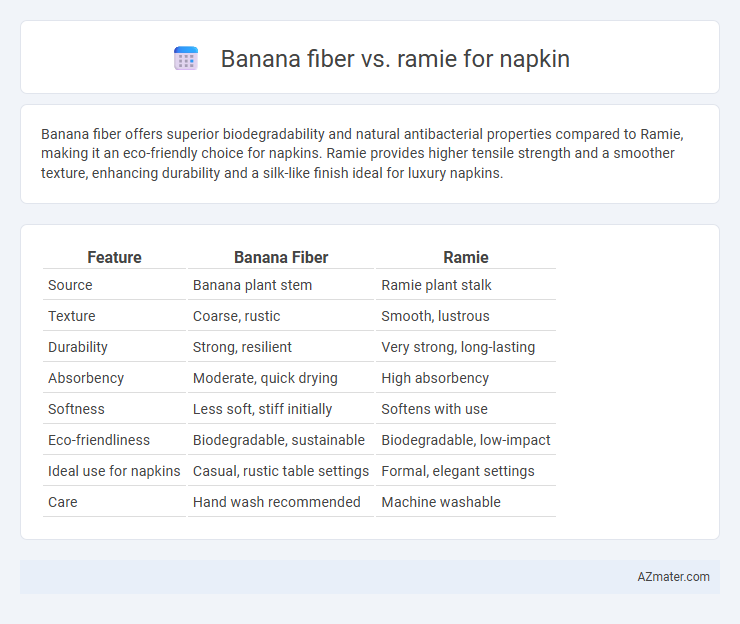Banana fiber offers superior biodegradability and natural antibacterial properties compared to Ramie, making it an eco-friendly choice for napkins. Ramie provides higher tensile strength and a smoother texture, enhancing durability and a silk-like finish ideal for luxury napkins.
Table of Comparison
| Feature | Banana Fiber | Ramie |
|---|---|---|
| Source | Banana plant stem | Ramie plant stalk |
| Texture | Coarse, rustic | Smooth, lustrous |
| Durability | Strong, resilient | Very strong, long-lasting |
| Absorbency | Moderate, quick drying | High absorbency |
| Softness | Less soft, stiff initially | Softens with use |
| Eco-friendliness | Biodegradable, sustainable | Biodegradable, low-impact |
| Ideal use for napkins | Casual, rustic table settings | Formal, elegant settings |
| Care | Hand wash recommended | Machine washable |
Introduction to Sustainable Textiles for Napkins
Banana fiber and ramie are both eco-friendly textiles ideal for sustainable napkins due to their natural origins and biodegradability. Banana fiber, derived from the pseudo-stem of banana plants, offers strength and absorbency, making it a durable choice for repeated use in napkins. Ramie, a bast fiber from the stalks of the ramie plant, provides a silky texture and resistance to bacteria, ensuring napkins remain fresh and long-lasting while reducing ecological impact.
Overview of Banana Fiber and Ramie
Banana fiber, derived from the pseudostem of banana plants, is a strong, biodegradable material known for its durability and natural luster, making it an eco-friendly choice for napkins. Ramie, extracted from the stalks of the Chinese grass plant, possesses a silky texture, excellent moisture absorption, and resistance to bacterial growth, enhancing its suitability for reusable napkins. Both fibers offer sustainable alternatives to conventional textiles, with banana fiber providing ruggedness and ramie offering softness and hygienic benefits.
Environmental Impact: Banana Fiber vs Ramie
Banana fiber, derived from the agro-waste of banana plants, offers a highly sustainable alternative due to its full biodegradability and minimal water usage during production compared to ramie. Ramie, while also biodegradable, requires more intensive chemical processing and higher water consumption, increasing its environmental footprint. Choosing banana fiber for napkins significantly reduces resource depletion and pollution, making it the greener choice in textile manufacturing.
Cultivation and Harvesting Processes
Banana fiber is derived from the pseudostems of banana plants, primarily cultivated in tropical regions with minimal chemical inputs, harvested by manually extracting the fiber after the fruit is picked. Ramie is a bast fiber obtained from the stalks of Boehmeria plants, grown in subtropical climates requiring harvesting two to three times a year through retting, decortication, and drying processes. The cultivation of banana plants supports sustainable agriculture by using crop residues, while ramie demands more labor-intensive retting for fiber separation, affecting production efficiency for napkin manufacturing.
Fiber Extraction Methods: A Comparative Analysis
Banana fiber extraction involves decorticating the pseudostem followed by water retting or mechanical scrapping to separate the fibers, producing coarse but strong fibers ideal for Napkin durability. Ramie extraction employs degumming after harvesting stalks, where chemical or enzymatic retting removes gummy substances, resulting in finer, lustrous, and highly absorbent fibers suited for soft and elegant linens. The difference in extraction significantly impacts the texture and strength of the napkin fabric, with banana fibers offering robustness and ramie fibers providing smoothness and sheen.
Durability and Strength in Napkin Use
Banana fiber provides high tensile strength and excellent durability, making it ideal for repeated washing and everyday use in napkins. Ramie fiber is known for its exceptional strength and resistance to wear, maintaining fabric integrity even after frequent laundering. Both fibers outperform cotton in durability, but ramie offers superior stiffness and resilience, while banana fiber excels in flexibility and softness for comfortable napkin use.
Absorbency and Comfort: Which Performs Better?
Banana fiber, known for its high absorbency, efficiently soaks up moisture, making it an excellent choice for napkins intended for quick drying and spill management. Ramie offers a smooth texture with moderate absorbency and exceptional durability, enhancing comfort with its silk-like softness and resistance to wear. For napkins prioritizing absorbency and comfort, banana fiber excels in moisture retention, while ramie provides superior softness and long-lasting comfort.
Biodegradability and End-of-Life Options
Banana fiber offers superior biodegradability compared to ramie, breaking down naturally without releasing harmful substances, which makes it ideal for eco-friendly napkins. Ramie, while durable and biodegradable, decomposes more slowly due to its higher lignin content, affecting its end-of-life environmental impact. Both fibers support composting, but banana fiber's faster degradation reduces landfill burden and promotes sustainable waste management for disposable napkins.
Cost and Market Availability of Both Fibers
Banana fiber is generally more affordable than ramie due to its abundant agricultural waste source, leading to lower raw material costs. Ramie, though valued for its silky texture and strength, tends to be pricier and less widely available because of limited cultivation regions, primarily in China and Southeast Asia. Market availability favors banana fiber for napkins in regions with established banana farming, while ramie is often found in niche markets targeting premium textile products.
Conclusion: Choosing the Best Fiber for Eco-Friendly Napkins
Banana fiber offers excellent biodegradability, natural antibacterial properties, and a soft texture ideal for eco-friendly napkins, while ramie provides superior strength and durability with a silky appearance, making it suitable for long-lasting use. Considering sustainability, banana fiber is harvested from agricultural waste, promoting zero waste, whereas ramie cultivation requires more water and processing chemicals. For environmentally conscious consumers prioritizing biodegradability and renewable sourcing, banana fiber is the preferred choice, while ramie suits those seeking enhanced durability and a refined aesthetic.

Infographic: Banana fiber vs Ramie for Napkin
 azmater.com
azmater.com